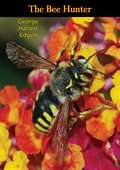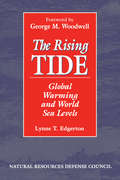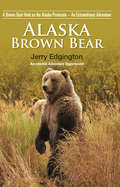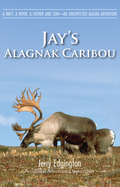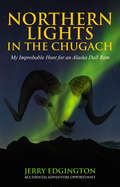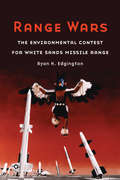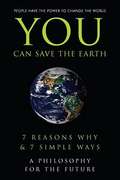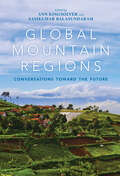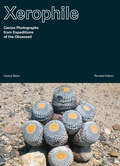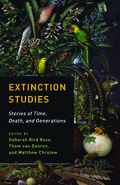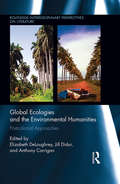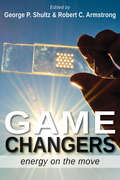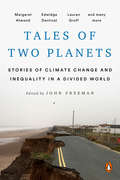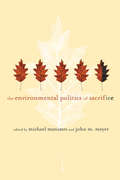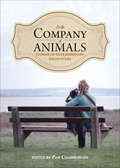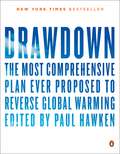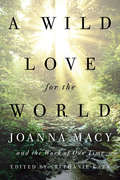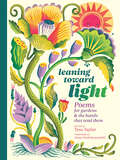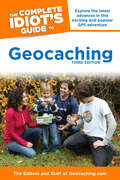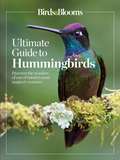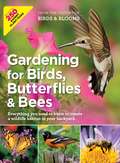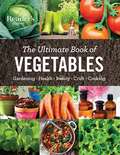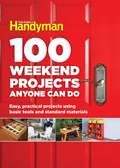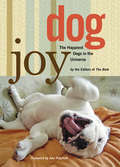- Table View
- List View
The Bee Hunter
by George Harold EdgellOriginally published in 1949, this amusing and informative little book gives a charming account of an avocation seriously pursued by the author for fifty summers. It provides as well, with clarity and wit, a manual for lovers of nature (and wild honey) who might wish to undertake this ingenious sport. George Harold Edgell sticks his neck out on the first page and says no other book describing the proper approach to wild bees exists. “It is time,” he says, “for someone who has hunted bees and found bee trees to write the facts.”
The Rising Tide: Global Warming And World Sea Levels
by Lynne EdgertonThe Rising Tide is the first analysis of global warming and world sea level rise. It outlines state, national, and international actions to respond to the effects of global warming on coastal communities and ecosystems.
Alaska Brown Bear: A Brown Bear Hunt on the Alaska Peninsula – An Extraordinary Adventure
by Jerry EdgingtonFew experiences in life are true adventures; even fewer are truly extraordinary. Rarely, very rarely are they both; where the past and the future collide in an unforgettable present moment. Where the senses, the intellect and the spirit and harmony in the experience. I hadn't imagined that an Alaska Peninsula bear hunt would be one of those adventures. I've experienced moments of truth when hunting—the rush of spotting game, the stalk, and the shot. But that changed on this hunt. Connecting to the transcendent silence of Alaska, nature as pure as it comes; that became my real moment of truth. It became my real world, more than the one I had le behind. My bear hunt was more than I expected and maybe more than I was prepared for, but not more than I wanted, or needed, and in the end it had little to do with getting a bear.
Jay's Alagnak Caribou: A Raft, A River, A Father and Son—An Unexpected Alaska Adventure
by Jerry EdgingtonJay and his dad knew things would change after summer. The seasons of boy scouts, little league, high school sports, and just hanging out, would be gone forever. But there was a chapter left to write, and it would be written on a long section of the Alagnak River in Alaska. It wouldn't be the final chapter, not by a long stretch, but it would be a transcending chapter. A self-guided moose hunt and fishing trip would be a proper way to commemorate Jay's 19th birthday. So, with fishing rods and guns, and a flight into the headwaters of the Alagnak River they embarked on their adventure. What they found was more than they imagined—much more. They found the Alaska wilderness and a freedom they didn't know existed. They found a life changing adventure—built unbreakable bonds.
Northern Lights in the Chugach: My Improbable Hunt for an Alaska Dall Ram
by Jerry EdgingtonMy hunt for a Dall ram in the Chugach Mountains of Alaska became an epic adventure and stretched me beyond my limits, or so I thought. High on the rocky face of a steep mountainside, I found myself both physically and mentally spent. Exhaustion and confusion are a dangerous combination in a spot like that. Sweat stung my eyes and ran off my nose. My heartbeat pulsed in my ears and my arms and legs were limp with fatigue. I reached deep for a little more grit and climbed on. At the top of the next pitch I found a flat section of grass about the length of my body, an oasis and a reprieve from the misery. Life altering epiphanies come at a price. Amid the northern nights in the Chugach Mountains I found a bigger world than I'd ever known.
Range Wars: The Environmental Contest for White Sands Missile Range
by Ryan H. EdgingtonEstablished in south-central New Mexico at the end of World War II, White Sands Missile Range is the largest overland military reserve in the western hemisphere. It was the site of the first nuclear explosion, the birthplace of the American space program, and the primary site for testing U.S. missile capabilities.In this environmental history of White Sands Missile Range, Ryan H. Edgington traces the uneasy relationships between the military, the federal government, local ranchers, environmentalists, state game and fish personnel, biologists and ecologists, state and federal political figures, hunters, and tourists after World War II—as they all struggled to define and productively use the militarized western landscape. Environmentalists, ranchers, tourists, and other groups joined together to transform the meaning and uses of this region, challenging the authority of the national security state to dictate the environmental and cultural value of a rural American landscape. As a result, White Sands became a locus of competing geographies informed not only by the far-reaching intellectual, economic, and environmental changes wrought by the cold war but also by regional history, culture, and traditions.
You Can Save The Earth: A Philosophy For The Future
by June EdingWith a fresh, philosophical approach, this work outlines simple and rewarding ways individuals can take action for the good of the Earth--and themselves.
Global Mountain Regions: Conversations toward the Future (Framing the Global)
by Edited by Ann Kingsolver and Sasikumar BalasundaramWorks exploring the responses of global mountain communities to the shared challenges and opportunities their unique locations afford them.No matter where they are located in the world, communities living in mountain regions have shared experiences defined in large part by contradictions. These communities often face social and economic marginalization despite providing the lumber, coal, minerals, tea, and tobacco that have fueled the growth of nations for centuries. They are perceived as remote and socially inferior backwaters on one hand while simultaneously seen as culturally rich and spiritually sacred spaces on the other. These contradictions become even more fraught as environmental changes and political strains place added pressure on these mountain communities. Shifting national borders and changes to watersheds, forests, and natural resources play an increasingly important role as nations respond to the needs of a global economy.The works in this volume consider multiple nations, languages, generations, and religions in their exploration of upland communities’ responses to the unique challenges and opportunities they share. From paintings to digital mapping, environmental studies to poetry, land reclamation efforts to song lyrics, the collection provides a truly interdisciplinary and global study. The editors and authors offer a cross-cultural exploration of the many strategies that mountain communities are employing to face the concerns of the future.“Global Mountain Regions is an outstanding addition to the inventory of the interdisciplinary field of montology, the study of mountains. For any scholar or student interested in the human dimensions of mountain regions, many if not all of the essays will be valuable references.” —American Ethnologist
Xerophile, Revised Edition: Cactus Photographs from Expeditions of the Obsessed
by Edited by Cactus StoreAn updated edition of the cult classic, featuring stunning archival photographs of hundreds of the rarest and most spectacular plants on Earth, taken by a motley crew of cactus obsessives &“A catalogue of wonders that most of us will never get to see in person.&”—The New YorkerFrom the people behind Cactus Store comes Xerophile, a photographic collection of these improbable desert wonders in the wild. Drawing on the archives of twenty-five cactus obsessives—from PhD botanist to banker, art teacher to cancer researcher—this revised edition spans eighty years and features new and expanded descriptive notes for all 350+ photos.Xerophile brings together eighty years&’ worth of these explorers&’ remarkable images from some of the world&’s most remote habitats: a peculiar two-leaved plant that lives for millennia in the deserts of Namibia; succulents whose poisonous sap is used by hunters to fell large game in Angola; and cactus that live on snow-covered mountains in Bolivia, sink below ground level to survive droughts in Mexico, are pollinated by bats in Brazil, and grow in pure lava fields of the Galápagos Islands.
Extinction Studies: Stories of Time, Death, and Generations
by Edited by Deborah Bird Rose Thom Van Dooren Matthew ChrulewExtinction Studies focuses on the entangled ecological and social dimensions of extinction, exploring the ways in which extinction catastrophically interrupts life-giving processes of time, death, and generations. The volume opens up important philosophical questions about our place in, and obligations to, a more-than-human world. Drawing on fieldwork, philosophy, literature, history, and a range of other perspectives, each of the chapters in this book tells a unique extinction story that explores what extinction is, what it means, why it matters—and to whom.
Global Ecologies and the Environmental Humanities: Postcolonial Approaches (Routledge Interdisciplinary Perspectives on Literature)
by Edited by Elizabeth DeLoughrey, Jill Didur, and Anthony CarriganThis book examines current trends in scholarly thinking about the new field of the Environmental Humanities, focusing in particular on how the history of globalization and imperialism represents a special challenge to the representation of environmental issues. Essays in this path-breaking collection examine the role that narrative, visual, and aesthetic forms can play in drawing attention to and shaping our ideas about long-term and catastrophic environmental challenges such as climate change, militarism, deforestation, the pollution and management of the global commons, petrocapitalism, and the commodification of nature. The volume presents a postcolonial approach to the environmental humanities, especially in conjunction with current thinking in areas such as political ecology and environmental justice. Spanning regions such as Africa, Asia, Eastern Europe, Latin America and the Caribbean, Australasia and the Pacific, as well as North America, the volume includes essays by founding figures in the field as well as new scholars, providing vital new interdisciplinary perspectives on: the politics of the earth; disaster, vulnerability, and resilience; political ecologies and environmental justice; world ecologies; and the Anthropocene. In engaging critical ecologies, the volume poses a postcolonial environmental humanities for the twenty-first century. At the heart of this is a conviction that a thoroughly global, postcolonial, and comparative approach is essential to defining the emergent field of the environmental humanities, and that this field has much to offer in understanding critical issues surrounding the creation of alternative ecological futures.
Game Changers: Energy on the Move
by Edited by George Shultz and Robert ArmstrongIt is becoming increasingly obvious that the United States needs reliable and inexpensive energy to propel our economy and protect our national security interests. Game Changers presents five research and development efforts from American universities that offer a cheaper, cleaner, and more secure national energy system. Drawing from the efforts of the MIT Energy Initiative (MITEI) and other leading university research centers, the book describes some of the energy innovations that will transform our future: natural gas from shales, solar photovoltaics, grid-scale electricity storage, electric cars, and LED lighting. For each of these innovations, the authors detail what is available today, what is near at hand, and what is on the horizon. In addition, they show how extreme energy reliability and performance demands put the United States military at the leading edge of driving energy innovations, and survey potentially game-changing energy technologies currently being put into use by the U.S. Army, Navy, Marine Corps, and Air Force, on base and in forward deployment. The more choices our laboratories put on the table, the less constrained we are in using them to reach the things we really care about—health, family, business, culture, faith, and delight. This is what game changers are ultimately about.
Tales of Two Planets: Stories of Climate Change and Inequality in a Divided World
by Edited by John FreemanBuilding from his acclaimed anthology Tales of Two Americas, beloved writer and editor John Freeman draws together a group of our greatest writers from around the world to help us see how the environmental crisis is hitting some of the most vulnerable communities where they live.In the past five years, John Freeman, previously editor of Granta, has launched a celebrated international literary magazine, Freeman's, and compiled two acclaimed anthologies that deal with income inequality as it is experienced. In the course of this work, one major theme came up repeatedly: Climate change is making already dire inequalities much worse, devastating further the already devastated. But the problems of climate change are not restricted to those from the less developed world.Galvanized by his conversations with writers and activists around the world, Freeman engaged with some of today's most eloquent storytellers, many of whom hail from the places under the most acute stress--from the capital of Burundi to Bangkok, Thailand. The response has been extraordinary. Margaret Atwood conjures with a dys¬topian future in a remarkable poem. Lauren Groff whisks us to Florida; Edwidge Danticat to Haiti; Tahmima Anam to Bangladesh; Yasmine El Rashidi to Egypt, while Eka Kurniawan brings us to Indonesia, Chinelo Okparanta to Nigeria, and Anuradha Roy to the Himalayas in the wake of floods, dam building, and drought. This is a literary all-points bulletin of fiction, essays, poems, and reportage about the most important crisis of our times.
The Environmental Politics of Sacrifice (The\mit Press Ser.)
by Edited by Michael Maniates John M. MeyerAn argument that the idea of sacrifice, with all its political baggage, opens new paths to environmental sustainability.The idea of sacrifice is the unspoken issue of environmental politics. Politicians, the media, and many environmentalists assume that well-off populations won't make sacrifices now for future environmental benefits and won't change their patterns and perceptions of consumption to make ecological room for the world's three billion or so poor eager to improve their standard of living. The Environmental Politics of Sacrifice challenges these assumptions, arguing that they limit our policy options, weaken our ability to imagine bold action for change, and blind us to the ways sacrifice already figures in everyday life. The concept of sacrifice has been curiously unexamined in both activist and academic conversations about environmental politics, and this book is the first to confront it directly. The chapters bring a variety of disciplinary perspectives to the topic. Contributors offer alternatives to the conventional wisdom on sacrifice; identify connections between sacrifice and human fulfillment in everyday life, finding such concrete examples as parents' sacrifices in raising children, religious practice, artists' pursuit of their art, and soldiers and policemen who risk their lives to do their jobs; and examine particular policies and practices that shape our understanding of environmental problems, including the carbon tax, incentives for cyclists, and the perils of green consumption. The Environmental Politics of Sacrifice puts “sacrifice” firmly into the conversation about effective environmental politics and policies, insisting that activists and scholars do more than change the subject when the idea is introduced.ContributorsPeter Cannavò, Shane Gunster, Cheryl Hall, Karen Litfin, Michael Maniates, John M. Meyer, Simon Nicholson, Anna Peterson, Thomas Princen, Sudhir Chella Rajan, Paul Wapner, Justin Williams
In the Company of Animals: Stories of Extraordinary Encounters
by Edited by Pam ChamberlainReal-life tales that explore the complexities of human-animal relationships—from domestic pets to farm animals to wildlife.In this collection, thirty-seven writers from across Canada tell thought-provoking stories of extraordinary encounters with a variety of animals—from rats and salamanders to wolves and bears. From tributes to a favorite cat or dog to tales of a chance encounter with a moose or a cougar, these stories are sure to entertain and enlighten. The writers are people who spend time in the company of animals—pet owners, farmers, veterinarians, hunters, artists, landowners, game wardens—those who pay close attention to them and their natures, and the lessons they can teach us.
Drawdown: The Most Comprehensive Plan Ever Proposed to Reverse Global Warming
by Edited by Paul Hawken• New York Times bestseller •The 100 most substantive solutions to reverse global warming, based on meticulous research by leading scientists and policymakers around the world&“At this point in time, the Drawdown book is exactly what is needed; a credible, conservative solution-by-solution narrative that we can do it. Reading it is an effective inoculation against the widespread perception of doom that humanity cannot and will not solve the climate crisis. Reported by-effects include increased determination and a sense of grounded hope.&” —Per Espen Stoknes, Author, What We Think About When We Try Not To Think About Global Warming &“There&’s been no real way for ordinary people to get an understanding of what they can do and what impact it can have. There remains no single, comprehensive, reliable compendium of carbon-reduction solutions across sectors. At least until now. . . . The public is hungry for this kind of practical wisdom.&” —David Roberts, Vox&“This is the ideal environmental sciences textbook—only it is too interesting and inspiring to be called a textbook.&” —Peter Kareiva, Director of the Institute of the Environment and Sustainability, UCLAIn the face of widespread fear and apathy, an international coalition of researchers, professionals, and scientists have come together to offer a set of realistic and bold solutions to climate change. One hundred techniques and practices are described here—some are well known; some you may have never heard of. They range from clean energy to educating girls in lower-income countries to land use practices that pull carbon out of the air. The solutions exist, are economically viable, and communities throughout the world are currently enacting them with skill and determination. If deployed collectively on a global scale over the next thirty years, they represent a credible path forward, not just to slow the earth&’s warming but to reach drawdown, that point in time when greenhouse gases in the atmosphere peak and begin to decline. These measures promise cascading benefits to human health, security, prosperity, and well-being—giving us every reason to see this planetary crisis as an opportunity to create a just and livable world.
A Wild Love for the World: Joanna Macy and the Work of Our Time
by Edited by Stephanie KazaJoanna Macy is a scholar of Buddhism, systems thinking, and deep ecology whose decades of writing, teaching, and activism have inspired people around the world. In this collection of writings, leading spiritual teachers, deep ecologists, and diverse writers and activists explore the major facets of Macy&’s lifework. Combined with eleven pieces from Macy herself, the result is a rich chorus of wisdom and compassion to support the work of our time. &“Being fully present to fear, to gratitude, to all that is—this is the practice of mutual belonging. As living members of the living body of Earth, we are grounded in that kind of belonging. Even when faced with cataclysmic changes, nothing can ever separate us from Earth. We are already home.&”— Joanna Macy
Leaning toward Light: Poems for Gardens & the Hands That Tend Them
by Edited by Tess TaylorThis beautiful poetry anthology offers a warm, inviting selection of poems from a wide range of voices that speak to the collective urge to grow, tend, and heal—an evocative celebration of our connection to the green world. Caring for plants (much like reading a good poem) brings comfort, solace, and joy to many—offering an outlet in difficult times to slow down and steward growth. In Leaning toward Light, acclaimed poet and avid gardener Tess Taylor brings together a diverse range of contemporary voices to offer poems that celebrate that joyful connection to the natural world. Several of the most well-known contemporary writers, as well as some of poetry&’s exciting rising stars, contribute to this collection including Ross Gay, Jericho Brown, Mark Doty, Jane Hirshfield, Ada Limón, Danusha Laméris, Naomi Shihab Nye, Garret Hongo, Ellen Bass, and James Crews. Select poems are paired with reflective pauses and personal recipes from the authors, and colorful illustrations are featured throughout. Plus, the gorgeous hardcover package with ribbon bookmark makes this anthology a distinctive gift. Gardening offers a rich and expansive subject, with poems moving thematically through the year from planting and weeding to harvesting and eating. Poets find purpose in browsing a seed catalog and comfort in picking green tomatoes despite California&’s wildfire season raging on—reminding us how gardening is a healing practice, both for ourselves and the spaces we tend. The range of experience reflected, from caring for a few houseplants to an expansive garden or farm, offers wide appeal and illuminating insights for gardeners, plant lovers, or anyone interested in connecting more deeply with the earth. This publication conforms to the EPUB Accessibility specification at WCAG 2.0 Level AA.
The Complete Idiot's Guide to Geocaching, 3rd Edition: Explore the Latest Advances in This Exciting and Popular GPS Adventure
by Editors & Staff Geocaching.comGeocaching has steadily grown into a fun and enduring outdoor adventure and with the popularity of GPS units and the development of applications for nearly all of the most popular smartphone platforms, it has become an adventure that's available to pretty much anyone. In The Complete Idiot's Guide® to Geocaching, Third Edition, the editors and staff of Geocaching.com open the world of geocaching up to a much broader audience and take the reader through all of the core essentials for caching including how to play, tips and tricks for finding and placing caches, variations on traditional caching, and much more. In addition, the reader can learn about exciting new changes to the game and the new GPS-enabled games that will take cachers to an entirely new level of fun and adventure.
Birds & Blooms Ultimate Guide to Hummingbirds: Discover the wonders of one of nature's most magical creatures
by Editors at Birds and BloomsUltimate Guide to Hummingbirds will ignite your curiosity and immerse you in the world of these tiny marvels.Everyone knows and loves these energetic little fliers. Experience the magic yourself with this must-have book! Find out exactly what makes them tick, including how they hover and fly backwards, the intriguing way they consume nectar and how to keep them coming back to your yard year after year with the right plant picks and top-notch feeding tips. CHAPTERS 1. Hummingbird Basics & Beyond 2. Feeding 101 3. Create a Winning Hummingbird-Friendly Habitat 4. Best Plant Picks 5. Beyond the Backyard 6. Hummingbird Tales 7. Ask the Experts 8. DIY Projects
Gardening for Birds, Butterflies, and Bees
by Editors at Birds Blooms MagazineWhether you’re installing a new garden bed or trying to attract orioles for the first time, it helps to start with the right information. And here it is! In this book, experts and readers from North America's #1 Bird and Garden Magazine, Birds & Blooms, give their tried-and-true advice.Attracting birds and butterflies has never been simpler—plus you’ll get the latest tips and advice for supporting the dwindling bee population, which experts say is essential for the future of gardening. Inside this book, you’ll find irresistible plants for birds, butterflies, and bees, creative garden designs for year-round beauty, and our top plant lists to take the guesswork out of gardening. No matter what the subject, everyone wants advice they can trust. This is certainly the case when it comes to the backyard. Whether you’re installing a new garden bed or trying to attract orioles for the first time, it helps to start with the right information. And here it is! Birds, butterflies and bees rely on plants, trees and shrubs to survive and thrive. That’s why doing your part for the environment by establishing critter-friendly areas in your own backyard is so crucial. Chances are, your garden is already a welcoming space for all kinds of nature, but with a little extra research and planning, you can take your gardening a couple steps further and transform your yard into a healthier and happier sanctuary for birds, butterflies and bees. This book, brought to you by the editors of Birds & Blooms magazine, can serve as your guide to attracting new visitors to your landscape. Birds & Blooms has helped lead the trend we like to call “gardening with a purpose” for over 20 years. We’ve always recognized the importance of going beyond just the beauty of a garden, and purposefully choosing flowers, trees and shrubs specifically for their environmental benefits. Birds count on healthy trees and plants as natural food sources and nesting sites. Butterflies need nectar-rich blooms for nourishment. Very specific host plants are key to caterpillar survival. And as bee populations decline, flowers that provide nectar and pollen are more essential than ever. Each of these creatures requires natural shelter as well, which trees and shrubs readily provide. If you’re ready to commit to sharing your garden with all sorts of nature, sit down with this book and let us help you create a successful space. All of the 250+ featured plants are not only gorgeous and colorful, but they offer a lot of environmental benefits, too. We made sure to include amazing photos of every plant we’re recommending, so you’ll be able to see what each plant looks like and immediately know if it’s a good fit for your garden. We even went a step further and put together some handy symbols to help you achieve the wildlife-friendly backyard of your dreams. Look for the symbols next to each plant profile to discover what the plant will attract. (Some plants are a triple whammy and attract birds, butterflies and bees!) For extra guidance, check the light-requirement symbols. You’ll be able to quickly see if a plant should be grown in shade, part-shade or full sun—vital info you need to know to create a great habitat. Once you’ve established a flourishing backyard, be sure to enjoy your new guests. Throughout this book, we’ve highlighted about 70 bird species and 35 butterfly species you might see in your space. Have fun identifying all of the birds, butterflies and bees in your own backyard!
The Ultimate Book of Vegetables: Gardening, health, Beauty, Crafts, Cooking
by Editors at Reader's DigestThe Editors of Reader’s Digest present the definitive A-Z guide to vegetables and how to grow and use them.<P> This complete illustrated guide to vegetables unlocks the secrets of nature’s bounty with comprehensive information on the planting, harvesting, and storing of vegetables, together with a wealth of great ideas for using them in cooking, healthcare, crafts, vegetable dyes, home products, beauty treatments, and more.
100 Weekend Projects Anyone Can Do: Easy, practical projects using basic tools and standard materials
by Editors at The Family Handymanuild fashionable, functional, inexpensive indoor and backyard furniture--even if you're a complete beginner. These are realistic projects for the average weekend warrior that require no great skills, just normal tools you already have and easy-to-buy materials available at any home store. Here's a small sample of what's inside: Build a simple-but-stylish bookcase Cut garage clutter with oversized shelves Double your closet space with easy accessories Build a rock-solid workbench in 3 hours Maximize kitchen storage with clever cabinet inserts Build backyard furniture, a garden arbor, planters and more! Benches, garden and deck chairs Outdoor storage Quick projects like bird houses, handy hints, and more
PADI Open Water Diver manual 2006 Edition
by Editors at the PADIThe PADI Open Water Diver course consists of three segments: Confined water dives, knowledge development, and open water dives. Each plays an important role in learning to dive and in meeting the performance objectives you need to qualify as a diver. Knowledge development establishes the principles and basic information all divers need to have fun diving safely. It's divided into five segments that you'll complete primarily on your own time at your convenience using this manual and the PADI Open Water Diver Video. (In some instances you may view or review the video in a classroom setting.) For each segment, your instructor reviews and elaborates on the material, applying what you're learning to your specific needs, interests and the local dive environment. A short quiz confirms that you've picked up the information you need from that section.
DogJoy: The Happiest Dogs in the Universe
by Editors of Bark<p>There is no greater joy than seeing a beloved dog smile. <p>Whether they're greeting us at the door, romping with their pals, or celebrating a birthday, their happiness is completely infectious. Do dogs really smile? <p>We set out to prove this idea after a reader of The Bark sent in a photo of her grinning dog, with a suggestion for a contest ... and, the Smiling Dog contest was born. <p>So for the past eight years, enthusiastic dog lovers everywhere have been sending in photographs of their smiling pups. DogJoy assembles the best of the pack—presenting proof positive that dogs not only smile, but also laugh, grin, snicker and even share jokes. <p>Highlighted by personal stories and peppered with charming observations, dog lovers everywhere will adore this wonderful collection.
